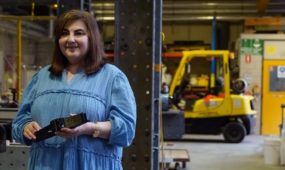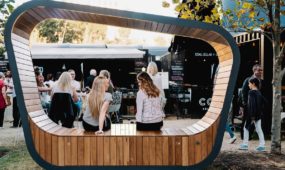Wood innovation looks beyond sawmilling to nail manufacturing process
Innovation
PRINCIPLES from the automotive, mining and paper industries have helped develop a machine to convert cheap pulpwood into a premium product with the same properties as tropical hardwood.

Sign up to receive notifications about new stories in this category.
Thank you for subscribing to story notifications.
Rather than only manufacturing the wood itself, the company behind the innovation is looking to commercialise the machine to fuel its production globally.
The new wood-processor was designed by 3RT in Adelaide, South Australia, and uses research from Flinders University, machinery from CNC Design and software from Siemens Australia to wirelessly control production.
The company is set to unveil its pilot machine in December ahead of a global launch early next year.
Two 6-axis industrial robots, commonly found in the automotive industry, form part of the machine and operate using software found in the mining sector to enable remote access to the unit.
The machine also uses a paper industry-like production process. Veneered pulpwood logs are put through a forming station where a unique glue reconstitutes the material.
The radical nature of the production process, which flies in the face of traditionally sawmilling, encouraged 3RT Managing Director Peter Torreele to look to other industries to make the innovation a reality.
He said the design of the device did not rely on any input from members of the sawmilling industry.
“We used scientists and engineers from adjacent advanced manufacturing industries such as the automotive industry to bring sawmilling into the 21st Century,” Torreele said.
“It’s using all the new technologies to ensure we can make a factory at the lowest cost, at the fastest speed and that we can control it from a distance.
“With the help of Siemens we can create a future production unit in a virtual world and simulate the process so you can measure your throughputs, calculate the cost of your goods and view your bill of materials.
“We build it and connect it – It could be as small as the entry hold of a modern sawmill.”
3RT’s “nanoglue” is a formaldehyde free, water-based adhesive, which reacts with fibres in the wood to make it stronger.
It is then passed through an heating system and pre-cured before robots operating on a carwash-style gantry system wood into moulds.
Wooden blocks that come out of the system retain their original aesthetic but have the same structural properties as tropical hardwood.
Torreele said the “plug-and-play unit” was scalable and could be tailor-made to suit specific customer needs.
He said the machine could produce the same output in a week as a traditional hardwood sawmill could in about two months.
According to the Australian Bureau of Agricultural and Resource Economics and Sciences (ABARES), traditional sawmills use 25 to 75-year-old hardwood almost 70 per cent of which becomes sawing waste.
3RT’s production unit can use trees that are about 10 to 25-years-old and only about 25 per cent of the wood is wasted.
The digital production unit starts with an annual output of about 5000 cubic metres and can be scaled up to 20,000 cubic metres by adding three more presses within the gantry system.
Torreele said the system reduced the need to harvest mature hardwood forests.
He said the technology also had the potential to give the wood new properties that would make it resistant to termites, UV light, water and fire damage.
“There are a lot of materials with a very high carbon footprint, whereas wood has a very low carbon footprint,” Torreele said.
“We are aiming to replace all applications where today hardwood would be used if it were available – furniture, floors, frames and there are other possibilities – it is endless.”
South Australian tertiary institution TAFE SA is designing furniture made from 3RT’s hybrid wood to test the material.
The company’s pilot machine is being assembled at Adelaide’s Tonsley precinct, where researchers, innovators and manufacturers collaborate to develop South Australia’s high value industries.
Flinders University, Siemens and TAFE SA are all located at Tonsley.
Two of 3RT’s founders are also based at Flinders Tonsley.
3RT has received a grant from the South Australian Government to build a commercial unit in Mount Gambier, about 380km southeast of Adelaide. The production unit will be launched in December 2017.
The specific design of the machine is being kept under wraps until its launch.
Jump to next article



